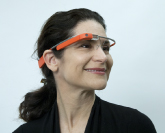SHOPPER MARKETING
SECTION ONE
SECTION TWO
SECTION THREE

Looking at Grocery Through Google Glass
By Liz Crawford
The first day I wore them I was treated like a celebrity. Pedestrians stopped me in the street. People in the
subway invited me to hold court. A couple from Spain declared me a VIP and took a picture of me with them
in Bryant Park. Why all this attention? Because I was wearing Google Glass.
As of this writing, Google Glass is still fairly new. There are only a few thousand people in the world who own them, and I have been lucky enough to be one. But 2014 is scheduled to be the year of its mass market debut, which - I am convinced - will mark a turning point in the history of technology. Google Glass will have important implications for grocery shoppers, retailers and manufacturers.
Google Glass is a new “wearable” computer, affixed to the rim of a pair of specially-designed glasses. Images and words appear in the upper right quadrant of the wearer’s vision. Nothing is held in the hand. It is controlled by voice recognition. It may also be controlled by tapping a finger on the frame.
The operations of a smartphone - and much more - are available on Google Glass. This includes making phone calls, texting, emailing, searching the web, getting news updates, navigating, translating foreign languages (visually or verbally), listening to music, taking videos and sharing it all on social media. Many of these functions are available on smartphones, but there’s a difference. Because it is hands-free and information floats in the wearer's field of vision, Glass is an interface to the world. It is not just a reference tool. Glass literally changes how I experience the world, as well as how I approach tasks.
For example, if I wink, I can take a picture of what’s in front of me; I can also get information about that subject and I can share it with hundreds of people, without interrupting any other activity. The hands-free, head-mounted photography has been one of the most talked about aspects of Glass. While hands-free photography is impressive and fun, hands-free bar code scanning may prove to be a killer app for brands. Here's why.
The app called Winky uses a deliberate wink of the right eye to snap a picture. Now imagine that instead of a snapping a photo, Winky (or something like it) could scan a barcode. Suppose I am placing my empty milk container into the recycle bin. But before I throw it in the bin, I scan the bar code with a wink, and it goes on my shopping list. I am throwing away an old container of mustard: wink, scan, and it’s on the list. By the end of the week, many items have accumulated, creating my grocery list. This list can be delivered or I can arrange to pick it up, just like I do now.
Of course, I could simply go to the grocery store - wearing Glass. In this case, the list floats in the right quadrant of my vision, while I walk down the grocery aisle. It isn't hard to imagine that there might be digital ads and celebrity demos appearing in front of products as I walk the aisles, too. The floating images that appear while wearing Glass are Augmented Reality (AR). Using AR for contextually relevant advertising is a topic unto itself.
But when it comes to CPG replenishment, I believe that hands-free list-making will have a big impact on weekly grocery shopping. Today, few shoppers use the list-making functions of apps. In fact, most still make handwritten lists. It seems faster to jot a note than fiddle with an app.
By offering instant, hands-free list-making, a wearable makes writing the onerous choice. Why bother finding paper and pen? Why bother digging for the list in the bottom of my purse? The list is easily accessible to me right in my field of vision whenever I like.
There is an implication here for brands and their trading partners. Grocery lists today are primarily composed of product categories such as bread, milk, toilet paper, etc., rather than brand names. Hands-free scanning changes this dynamic. By capturing the UPC code, the shopping list will be composed of specific brand names, flavors and sizes. This is considerably more particular than paper lists today. I believe this spells good news for most brands. What brand doesn’t want to be on a shopper’s list? Further, once a brand is on a scanned list, getting kicked off is harder... at least for those who are ordering directly from the list. Personalized ads could get triggered with the scan, too.
Google Glass may be only a stepping stone technology to something more sophisticated. But one thing is as clear as glass: Integrating computing into the shopping cycle is here to stay.
Liz Crawford is VP Strategy & Insights for Match ShopLab, a division of the Match Marketing Group. She is also the author of The Shopper Economy (McGraw-Hill, 2012). Liz can be reached at 203-803-6737 or liz.crawford@matchshoplab.com.
